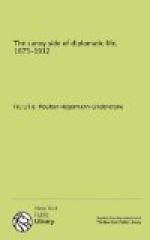ROME, HOLY WEEK, 1881.
My dear Aunt,—The churches are open all day. St. Peter’s, Laterano, Santa Maria Maggiore each has one of the famous sopranos. The music is—well, simply divine! I can’t say more. You must hear it to appreciate it. (Some day I hope you will.) Good Friday is the great day at St. Peter’s. The church is so crowded that one can hardly get a place to stand. There are not chairs enough in any of the churches during Holy Week for the numerous strangers that pervade Rome. My servant generally carries a camp-stool and rug, and I sit entranced, listening in the deepening twilight to the heavenly strains of Palestrina, Pergolese, and Marcello. Sometimes the soloists sing Gounod’s “Ava Maria” and Rossini’s “Stabat Mater,” and, fortunately, drown the squeaky tones of the old organ. A choir of men and boys accompanies them in “The Inflammatus,” where the high notes of M.’s tearful voice are almost supernatural. People swarm to the Laterano on Saturday to hear the Vespers, which are especially fine. After the solo is finished, the priests begin their monotonous Gregorian chants, and at the end of those they slap-bang their prayer-books on the wooden benches on which they are sitting, making a noise to wake the dead. I thought they were furious with one another and were refusing to sing any more. It seemed very out of place for such an exhibition of temper. A knowing friend told me that it was an old Jewish custom which had been repeated for ages on this particular day and at this hour. It closes the Lenten season.
On Easter Sunday I sang in the American church. Dr. Nevin urged me so much that I did not like to refuse. I chose Mendelssohn’s beautiful anthem, “Come unto Me.”
ROME, 1883.
Dear ——,—We have moved from the Palazzo Rospigliosi to the Palazzo Tittoni, in Via Rasella, which leads from the Palazzo Barberini down to the Fontana di Trevi. I never would have chosen this palace, beautiful as it is, if I could have foreseen the misery I suffer when I hear the wicked drivers goading and beating their poor beasts up this steep hill. The poor things strain every muscle under their incredible burdens, but are beaten, all the same. I am really happy when I hear the crow—I mean the bray—of a donkey. It has a jubiliant ring in it, as if he were somehow enjoying himself, and my heart sympathizes with him. But it may be only his way of expressing the deepest depths of woe.
Mrs. Charles Bristed, of New York, a recent convert to the Church of Rome, receives on Saturday evenings. She has accomplished what hitherto has been considered impossible—that is, the bringing together of the “blacks” (the ultra-Catholic party, belonging to the Vatican) and the “whites,” the party adhering to the Quirinal. These two parties meet in her salon as if they were of the same color. The Pope’s singers are the great attraction. She must either have a tremendously long purse or great persuasive powers to get them, for her salon is the only place outside the churches where one can hear them. Therefore this salon is the only platform in Rome where the two antagonistic parties meet and glare at each other.




